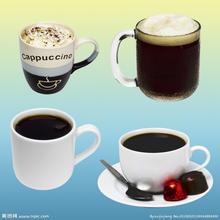Introduction to the blending proportion of deep-roasted and light-roasted coffee
When storing beans, the biggest enemy is moisture. The volatile oils that give us our aromas are soluble in water, and moisture affects the oils. Don't store coffee in the refrigerator because once it's opened, moisture condenses on the surface of the container.
If you want to keep coffee well stored at any time, the best way is to put it in a freezer and make sure it is sealed in an airtight bag. Roasted beans can be stored in the freezer for more than a week. When you need them, don't try to thaw the beans, just put them in the grinder.
Coffee's other enemy is oxygen, which breaks down volatile aromatic oils. This is the importance of grinding beans directly before brewing coffee. When coffee is ground, its surface layer is exposed to the air, which means that the aromatic oil begins to evaporate and the flavor disappears into the air.
Don't store coffee next to strong tasting products such as tea. Coffee quickly absorbs the flavor of other substances.
If you buy coffee by mail, it's best to buy small quantities at a time. Even in larger quantities, you lose the value of the coffee, just as you lose its aroma.
American consumers now have a choice of more than 100 flavored coffees, many of which are exported. Flavor coffee is produced by coating roasted beans with a carrier oil and letting them spray quickly in the aroma. This practice began in the United States in the 1970s.
The most popular flavors are cocoa, mocha, bitter almonds and double cocoa. Orange liqueur and nutty flavours are also present, although serious coffee drinkers will underline raspberry, banana and creamy beans to make a clear distinction. The new coffee flavor introduced in the West is cardamom, which has long been added to coffee in the Middle East and is also a popular and traditional additive in Mexico.
One problem for small shops and strict coffee drinkers is that they need separate grinders for different coffee flavors, because any residue affects the taste of the next ground bean. When preparing a new flavor of coffee, you may find it necessary to buy a small and inexpensive grinder, or buy pre-ground coffee.
The top three coffee flavors most widely used in France and the United States are almond, vanilla and hazelnut. They sell best in summer, when coffee is usually drunk less often and iced coffee is the most pleasant option.
The phrase "coffee without caffeine doesn't taste like coffee" is only partially true. Caffeine itself has no particular taste except for a slight bitterness. When caffeine is removed, the taste is different, probably because other substances that contain aromas are also removed.
The decaffeinated green beans from all over the world are transported to Germany or Switzerland, where they are processed and sent to roasting centers around the world. Mexican green beans are often sent to Switzerland decaffeinated, then sent across the Atlantic to roasters in Santiago, and then returned to the country of origin.
Early decaf coffee referred to a method in which green beans expanded under high temperature steam, absorbed caffeine-destroying solvents, and then released the solvents and their residues under high temperature steam conditions. Then the factory packs them with methylene chloride, which protects them from other smells. However, methylene chloride was banned in Europe in 1995 because it can destroy the ozone layer when released into the air.
There is a method that requires only water and an activated carbon processor called Swiss Water Treatment. The process, patented by Coffex SA, is complex and expensive. include immersing that bean in water to remove caffeine and aromatic substances. Caffeine is removed in water by an activated carbon processor and beans are roasted. But the aroma is still in the water, so the water evaporates to concentrate it and spray it back onto the dried beans.
In recent years, coffee tastes have been changing around the world. As we have seen, the fastest and greatest change has been in the United States. Many coffee lovers hope that European countries will follow the example of the United States, leading to more manor coffee and origin coffee. Traditional European coffee sales are varietal blends or simply a simple "Guatemala." The benefits of blending coffee varieties over a wide variety of origins are consistency over long distances, less breakage, and simpler methods of preparation. However, these coffees do not meet the criteria for a real cup of Yauco Selecto or Kona. Now, the outlook for them and for those refined coffees is better than ever

Important Notice :
前街咖啡 FrontStreet Coffee has moved to new addredd:
FrontStreet Coffee Address: 315,Donghua East Road,GuangZhou
Tel:020 38364473
- Prev

Introduction to the blending of espresso
Macchiato espresso Magido Macchiato is more feminine and looks like a scaled-down version of cappuccino. The biggest difference between them, except that the weight of Ma Qiduo is 1/3 of that of cappuccino, Ma Qiduo only adds a layer of milk foam on top of kung fu coffee without adding milk, so the taste of espresso only stays on the lips, and the taste of espresso will not be diluted by milk.
- Next

Italian coffee beans are different from Italian coffee beans.
But even if there is a recipe, it doesn't mean much. Regardless of the blending, only one of the beans, different production areas in the same country, different cooperatives, different batches of beans of different grades, and different baking equipment baking curve baking methods, etc., can present slightly different flavors, the formula can not be mechanically copied. The general principle of blending is sour and sweet.
Related
- Does Rose Summer choose Blue, Green or Red? Detailed explanation of Rose Summer Coffee plots and Classification in Panamanian Jade Manor
- What is the difference between the origin, producing area, processing plant, cooperative and manor of coffee beans?
- How fine does the espresso powder fit? how to grind the espresso?
- Sca coffee roasting degree color card coffee roasting degree 8 roasting color values what do you mean?
- The practice of lattes: how to make lattes at home
- Introduction to Indonesian Fine Coffee beans-- Java Coffee producing area of Indonesian Arabica Coffee
- How much will the flavor of light and medium roasted rose summer be expressed? What baking level is rose summer suitable for?
- Introduction to the characteristics of washing, sun-drying or wet-planing coffee commonly used in Mantenin, Indonesia
- Price characteristics of Arabica Coffee Bean Starbucks introduction to Manning Coffee Bean Taste producing area Variety Manor
- What is the authentic Yega flavor? What are the flavor characteristics of the really excellent Yejasuffi coffee beans?

